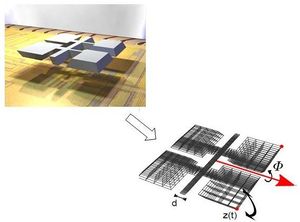Description
The device is a MEMS gyroscope based on the butterfly gyroscope[1]developed at the Imego institute in Gothenburg, Sweden (see also: Butterfly Gyroscope, where a non-parametrized model for the device is given ). A gyroscope is a device used to measure angular rates in up to three axes.
The basic working principle of the gyroscope can be described as follows, see also [2].
Without applied external rotation, the paddles vibrate in phase with the function  see xx--CrossReference--dft--fig:gyro--xx.
Under the influence of an external rotation about the
see xx--CrossReference--dft--fig:gyro--xx.
Under the influence of an external rotation about the  -axis (drawn in red),
an additional force due to the Coriolis acceleration acts upon the paddles.
This force leads to an additional small out-of-phase vibration between two paddles on the same side of the bearing.
This out-of phase vibration is measured as the difference of the
-axis (drawn in red),
an additional force due to the Coriolis acceleration acts upon the paddles.
This force leads to an additional small out-of-phase vibration between two paddles on the same side of the bearing.
This out-of phase vibration is measured as the difference of the  -displacement of the nodes with the red dots.
Thus, measuring the displacement of two adjacent paddles, the rotation velocity can be ascertained.
-displacement of the nodes with the red dots.
Thus, measuring the displacement of two adjacent paddles, the rotation velocity can be ascertained.
Motivation
When planning for and making decisions on future improvements of the butterfly gyroscope, it is of importance to improve the efficiency of the gyro simulations. Repeated analysis of the sensor structure have to be conducted with respect to a number of important issues. Examples of such are sensitivity to shock, linear and angular vibration sensitivity, reaction to large rates and/or acceleration, different types of excitation load cases and the effect of force-feedback. The use of model order reduction indeed decreases run time for repeated simulations.
The Parametrized Model
Two parameters are of special interest for the model.
The first one is the quantity that is to be sensed, the rotation velocity  around the
around the  -axes.
The second parameter is the width of the bearing,
-axes.
The second parameter is the width of the bearing,  .
The parametrized system below is obtained by finite element discretization of the parametrized model (in the form of partial differential equations) for the gyroscope.
The details of constructing the parametrized system can be found in [2].
The system is of the following form:
.
The parametrized system below is obtained by finite element discretization of the parametrized model (in the form of partial differential equations) for the gyroscope.
The details of constructing the parametrized system can be found in [2].
The system is of the following form:
Here,
 is the mass matrix,
is the mass matrix, is the damping matrix,
is the damping matrix, is the stiffness matrix,
is the stiffness matrix, is the load vector,
is the load vector, is the output matrix,
is the output matrix, is the state vector,
is the state vector,- and
 is the output response.
is the output response.
The quantity of interesting  of the system is
of the system is  ,
which is the difference of the displacement
,
which is the difference of the displacement  between the two red markings on the east side of the bearing (see xx--CrossReference--dft--fig:gyro--xx).
between the two red markings on the east side of the bearing (see xx--CrossReference--dft--fig:gyro--xx).
The parameters of the system,  and
and  ,
represent the width of the bearing(
,
represent the width of the bearing( ) and the rotation velocity along the
) and the rotation velocity along the  -axis (
-axis ( ),
with the ranges:
),
with the ranges: ![\theta\in [10^{-7}, 10^{-5}]](/morwiki/images/math/c/7/b/c7b0efa19e225aa5e038426cd80c3295.png) and
and ![d\in [1,2]](/morwiki/images/math/2/4/4/244c3333a4e36be25805ee4d952a245e.png) .
.
The device works in the frequency range ![f \in [0.025, 0.25]](/morwiki/images/math/8/f/1/8f1b9fd6143653e37abb4aeea17e1673.png) MHz and the degrees of freedom are
MHz and the degrees of freedom are  .
.
Data
The model is generated in ANSYS.
The system matrices  , and
, and  are in the MatrixMarket format, and can be downloaded here: Gyroscope_modi.tgz.
The matrix
are in the MatrixMarket format, and can be downloaded here: Gyroscope_modi.tgz.
The matrix  defines the output, which has zeros on all the entries, except on the 2315th entry, where the value is
defines the output, which has zeros on all the entries, except on the 2315th entry, where the value is  , and on the 5806th entry, the value is
, and on the 5806th entry, the value is  ;
in MATLAB notation, it is
;
in MATLAB notation, it is  and
and  .
.
Citation
To cite this benchmark, use the following references:
- For the benchmark itself and its data:
- The MORwiki Community. Modified Gyroscope. MORwiki - Model Order Reduction Wiki, 2018. http://modelreduction.org/index.php/Modified_Gyroscope
@MISC{morwiki_modgyro,
author = {The {MORwiki} Community},
title = {Modified Gyroscope},
howpublished = {{MORwiki} -- Model Order Reduction Wiki},
url = {http://modelreduction.org/index.php/Modified_Gyroscope},
year = {2018}
}
References
- ↑ J. Lienemann, D. Billger, E. B. Rudnyi, A. Greiner, J. G. Korvink, "MEMS Compact Modeling Meets Model Order Reduction: Examples of the Application of Arnoldi Methods to Microsystem Devices", Nanotech, 2004, pp. 303--306.
- ↑ 2.0 2.1 C. Moosmann, "ParaMOR Model Order Reduction for parameterized MEMS applications", PhD thesis, Department of Microsystems Engineering, University of Freiburg, Freiburg, Germany 2007.


